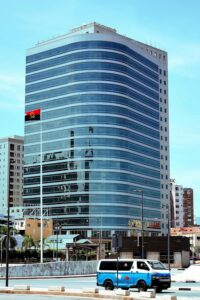“2015-2024-The Economics of Angola. Throughout this period, the economy went through several economic crises and large adjustments,” says the summary below with key breakdowns of the what important economic events and crises have occurred in these years.
1.Collapse of oil prices, 2014-2016: Angola thrives with oil. It’s largely 90% export-orientated and also 50%-51% contributive to government revenues. In 2014 mid, global oil prices began to see a steep decline, from a figure of over $100 per barrel, going as low as $30 early in 2016. This result of such high price changes saw a lot of negative economic effects:
Revenue Losses: Loss of government revenue from oil definitely has tremendous effects on public finances.
Currency Depreciation: The kwanza has suffered dramatic depreciation against the US dollar. In 2015, the Central Bank devalued the currency several times, while inflation rocketed as well.
Budget deficits: The government fell short of making ends meet in balancing its budget, leading to public expenditure reductions and delayed payments to contractors and suppliers, especially in infrastructural projects.
2.Crisis of currency, 2016-2018: The acute currency crisis hitting Angola in 2016 was highly brought about by the steep plunge in oil revenues. As oil revenues fell, the value of the national currency, the kwanza, substantially decreased. Between 2015 and 2017, the exchange rate moved from about 100 kwanzas per dollar to more than 200, and at one point it reached as high as 300 kwanzas per dollar. The main characteristics of the currency crisis could be summarized as follows:
Inflation: Inflation increased and hit 41.7% at its highest in 2016. It greatly worsened the cost of living for ordinary Angolans, affecting food prices as well as fuel prices.
Reduced Foreign Reserves: These dwindling foreign exchange reserves of Angola further worsened the depreciation of the currency and made it hard for the country to import goods, especially capital goods for industrial development.
IMF Bailout: Angola sought to stabilize the economy by requesting an IMF bailout late in 2017. This loan agreement was provided by the IMF, with conditions for fiscal reforms including improved management of the oil sector and currency liberalization.
- Reforming Government and Diversifying Economy (2017-2021) In 2017, Angola’s political landscape also changed, with João Lourenço replacing long-serving José Eduardo dos Santos as the head of state. The newly elected president has put in place a series of reforms aimed at restoration and rejuvenation of the economy:
Currency Liberalization: Angola introduced a “market-determined” exchange rate system for the kwanza in 2018, which has somewhat stabilized the currency. The Central Bank also put in place measures meant to enhance the transparency and liquidity of the foreign exchange market.
Anti-Corruption Campaign: A vigorous campaign against corruption was launched by Lourenço, targeting officials and elites very closely interfaced or associated with the former president. While the anti-corruption measures were thus acclaimed internationally, they have incited political and social tensions.
Diversification Efforts: Lourenço continued to urge diversification away from oil in his first term in office. However, the attempts were weakened by the volatility of oil prices in global markets. Yet, despite all these measures, Angola’s economy remains fragile and faces structural challenges: - Economic Depression and Rebound Vis-a-Vis Pandemic (2022-2024)
In the year 2022, the economy of Angola exhibited signs of gradual recovery but faced some challenges: - Oil Price Recovery: During 2022, the global oil price began to recover, leading to an economic boost in Angola. However, the country continued to record a decreased production level due to oil field output depletion.
- Inflation and Cost of Living: Despite inflating, with declines from their peaking level in the year 2016, inflation in the year 2023 averaged not less than 20 percent. Furthermore, the cost of living has continued to rise in the areas of food and transport, making them a top concern.
- Debt Servicing: Angola continued to be under the burden of debt servicing old external debt in foreign currency. There were still efforts on renegotiation and restructuring of debts.
- Diversification Progress: Some signs of improvement showed in some areas of agriculture, mining, and manufacturing growth, but oil remained an economic fluidity issue for Angola.
- More Investment in Infrastructure (2023-2024)
- Thus, by 2023 and 2024, Angola had started putting more emphasis on attracting foreign investment and diversifying its economy. Among the investment promotion areas were:
- Mining: Angola has numerous minerals beyond oil such as diamonds, iron ore, and copper. The new government initiatives to promote mining and attract foreign investment to the sector were launched in 2023.
- Agriculture: In 2024, Angola increasingly turned its mind to agriculture as an area with growth potential. Given its climate and large areas under plough, the government will promote local food production to decrease reliance on imports.
- Infrastructure Projects: There were also new efforts to improve national infrastructure, including roads, ports, and energy supply, with an emphasis on renewable energy projects.Economic Outlook (2024): Conclusion
- Currently in the year 2024, Angola’s economy is gradually coming out of an economic slump, but it remains highly exposed to external hazards like oil price fluctuations. Diversifying the economy continues to be an effort by the government, yet oil dependency-induced challenges will still continue. This includes high public debts and the low living standards of Angolans. It will depend very much on the global economic shifts, especially in energy markets, and whether Angola’s leadership is able to enforce radical changes.




